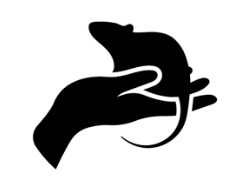The Social Rat (2) – Motivation – Why Are Rats Social?
We all know that Rattus norvegicus – the Brown or Norway rat – is a social species; colony dwellers who live within either hierarchical or territorial social systems, depending on the population density. We are also aware that our pet rats thrive in the company of other rats, and science tells us that stress levels are higher and lives shorter when rats are housed alone.
But how much do we know about the rat as a social creature? The origins of sociability? Its rewards and limitations for the rat? Or even what rats are capable of in terms of sociability? In this series of articles, we will dig deep into the social world of the rat to understand the weight of meaning behind those words we often hear within the pet rat world: “Rats need company, they shouldn’t be kept alone.”
So, we will begin at the beginning by taking a look at what social behaviour is and how it came about. Firstly, I would like to note that the content of this article – and any generalisations – refer to mammals. Social animals include many fish, birds, and insects, none of which I profess to know much about!
What is social behaviour?
Social behaviour refers to a set of interactions between members of the same species. We often
think about this in terms of positive interactions – a group of rats piled in a hammock are enjoying
social behaviour. But two wild rats fighting over territory are also engaged in social behaviour. As is a
rat who gives a warning vocalisation that a predator is in the vicinity – he exposes his own position
for the safety of the group.
All mammalian species have some social behaviours, even those who generally live in isolation. They
will interact:
to mate,
to raise offspring,
to gain mating rights,
to defend territories.
However, those who never seek social contact except to reproduce or fight tend to be considered asocial.
Why are animals social?
All social species have evolved because aspects of their co-operative behaviour have created an evolutionary advantage for the species. A few asocial species exist, and in mammals, most of these are apex predators for whom the costs of group living can outweigh the benefits. But for most species, some adaptation to social living is more likely to enable survival and reproduction, than to hinder it.
A variety of social strategies have arisen in mammals and evolved over time. These tend to vary between predators and prey animals as well between grazers, foragers, and hunters. Strategies include:
congregations (large gatherings of individuals who then act co-operatively as a whole).
packs (small, closely related, stable, and bonded groups).
colonies (vary in size, but often consist of small closely related family units living in individual burrows within a wider, more loosely connected group.
bonded pairs (sometimes living together within a larger group).
hierarchical groups (often groups of males living together within a hierarchy).
solitary but social (range and search for food alone but congregate to sleep together).
You might immediately see from this list that there can be overlap and fluidity between strategies. In high population densities, rats have been observed to live in colonies with hierarchical groups of males. At lower population densities males tend to be more solitary but social, maintaining a territory and reproductive control over a group of females in an individual burrow. Domesticated rats are almost always kept at high population densities (anything over approximately 1 rat per 10 square metres). Therefore, we are more likely to see hierarchical behaviours than territorial.
Rats are foraging prey animals, who also predate on small mammals and invertebrates. What they gain from social adaptation includes:
a communal early warning system in the face of danger.
a wider search area can be covered when seeking food, water, and other resources in the environment.
a greater degree of support and protection in raising offspring from living in related, female-dominated units.
access to the benefits of altruistic behaviour.
Understanding what a rat is gaining from social grouping helps us to anticipate the kind of behaviours that we might expect to see as a result. For example, social learning concerning food is a multifaceted and strong component of a rat’s foraging behaviour, and fear learning is accelerated by the fear-inducing experience of another group member.
The motivation for social living
Living in a group has clear advantages to the individual, but there are also costs. Resources need to be shared, conflicts need to be resolved (preferably without injury) and the social demands of others need to be met. Like all beneficial behavioural adaptations, social behaviour needs to FEEL rewarding. The emotional motivation to maintain social bonds can feel both positive and negative.
Positive emotional motivation
Through hormones and neurotransmitters, the rat’s body is continually rewarding social bonding activities like mating, lactation, snuggling, and grooming. Dopamine fuels motivation within the emotional seeking system (seeking a mate, for example), while hormones like opioids, oxytocin, and serotonin create positive emotional rewards (feelings we might label contentment, affection, safety, or love) in response to social bonding activities. These systems are thought to be inhibitors of social distress (separation anxiety) rather than – necessarily – a separate reward system.
Negative emotional motivation
The emotional panic system is present in all mammals and its primary purpose is thought to be maternal and infant bonding. The fear of social isolation and social loss (especially between mother and offspring causes an almost visceral pain, which may be because, anatomically, the areas of the brain involved seem to have arisen out of the physical pain centres. In social mammals, this separation anxiety has extended outwards to include all strong bonded relationships, or indeed the absence of any relationship (felt isolation).
The emotional panic of isolation and loss is mitigated by the opioid/oxytocin/dopamine systems in the brain. This is why rats are continually reinforcing social bonds through behaviours that release these hormones (such as snuggling and social grooming). Solitary rats cannot do this, so, live with ongoing increased anxiety, leading to chronic stress and a shortened lifespan. However, it should be noted that social stress can also isolate individuals within a group, with the same results. The solution is aiming for stable groups of 4 plus rats who have positive social bonds.
Not all rats are equal
There is a big BUT to add to all of this… while rats are an extremely sociable species, not all rats are equally sociable. Nor are they equal in terms of anxiety levels or their capacity to maintain positive social relationships. Perhaps it would be more accurate to say that what FEELS like a positive social relationship varies from rat to rat. Rats vary greatly in temperamental traits such as:
Predisposition to anxiety.
Degree of social neophobia.
Curiosity.
Dominance.
Aggressiveness.
Drive for exploration.
These traits merge to create rats who are introverted, extroverted, stable, unstable, welcoming of newcomers, fearful of newcomers, and so on. We will look at these social states in more detail as this series of articles progresses, but for now, it is enough to note that what a positive social relationship looks like to us can vary greatly between one rat and the next. All of these can be healthy and “normal” so long as the result is not enforced isolation, bullying, and social stress.
References
Affective Neuroscience – the foundationa of human and animal emotions. Jaak Panksepp
Nature.com
Ratbehaviour.org
Social Reward and Empathy as Proximal Contributions to Altruism: The Camaraderie Effect. Garet P.
Lahvis
Alison Campbell © 2020

